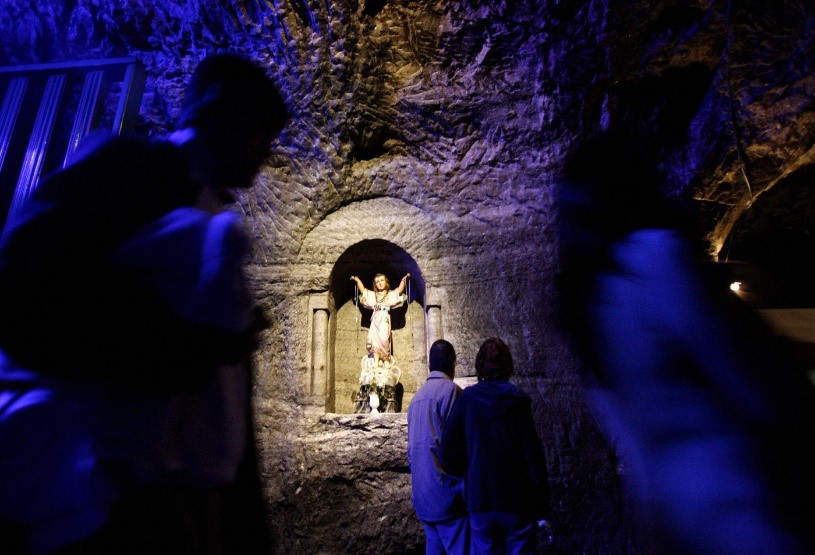Zipaquira
Department

Flag of the city
The flag of Zipaquirá features three equal horizontal bands. The top green band signifies the municipality’s prosperity; the central white band stands for its noble and royal heritage; while the bottom red band pays tribute to the city’s independence struggles and the valiant heroes who sacrificed their lives for it.

Flag of the city

Seal of the city
Slogan of the city
Zipaquirá, which is in Colombia, is widely recognized for its “Catedral de Sal” or Salt Cathedral, a magnificent church built inside a salt mine.
History
In the Abra Valley, situated between Zipaquirá and Tocancipá, some of South America’s oldest human remains have been discovered. These layers contain animal bones and carbon fragments which, through carbon-14 dating, are estimated to be about 12,500 years old. This positions them as the earliest evidence of human habitation in the Altiplano Cundiboyacense.
The name “Zipaquirá” has dual potential origins. One theory traces it to the local people living near the Zippa Mountains, named “Chicaquicha”, translating either as “our grand wall or city of Our Father.” Historically, up until the 19th century, this name began with the letter ‘C’. An alternative theory attributes the name to the titles “zipa” and “Quira”, given to the village’s leader and his spouse respectively, leading to “Zipa-Quirá”. The original indigenous settlers resided in what’s now Santiago Pérez, an area elevated about 200 meters from the current city’s location, where Spanish records from 1537 detail a population of around 12,000 people spread across hundreds of homes.
This territory once fell under the reign of the zipa of Bacatá, the Muisca’s southern chief. The Bogotá plain of that era featured lakes and canyons, enabling canoe transport. Communities like Nemocón, Gachancipá, and Tocancipá journeyed to Chicaquicha to trade pottery and tiles for salt. This salt was a prized trade item, reaching as far as the Andean regions of Colombia, including places like the Panche in today’s Tolima department and the Muzo in modern-day Boyacá.
On July 18, 1600, Don Luis Henríquez founded a community at the site, bringing workers and their kin, and named it “Village of Zipaquirá.”
By August 2, 1600, Henríquez commissioned Juan de Robles to build the Church of Zipaquirá. This structure was later revamped under Pedro de Tovar y Buendía’s supervision when Fernando de Buenaventura y Castillo was the parish’s priest.
In 1605, the region was christened Corregimiento de Zipaquirá and relocated to its initial site. This relocation was influenced by space constraints and a Spanish mandate prohibiting Spaniards, Blacks, Mestizos, and Mulattos from residing in indigenous communities, irrespective of land ownership.
In 1623, Don Francisco de Sosa documented 321 indigenous residents of the “Old Town”, as per Alfredo Tinoco’s statement.
On October 5, 1638, Gabriel de Carvajal assumed guardianship over 771 indigenous people in the vicinity and another 125 in Tibitó.
To curb recurring revolts by the former salt mine proprietors in 1778, Viceroy Manuel Antonio Flórez ordered the relocation of Zipaquirá’s indigenous inhabitants to Nemocón.
On August 3, 1779, the parishes of Holy Trinity and San Antonio de Padua were established in Zipaquirá.
By 1852, Zipaquirá was designated a province, a title it held until 1855.
During the Spanish resurgence on August 3, 1816, several individuals, now referred to as the Zipaquirá Martyrs, faced execution at the city’s central plaza.
Under the 1815 Cundinamarca Constitution, the city was named the capital of the province bearing the same title. On July 10, 1863, it became the capital of the Sovereign State of Cundinamarca. However, a subsequent decree by President Morales renamed it Funza. The Department of Quesada was established by Law 46 on April 29, 1905, designating Zipaquirá as its capital, a position it held until 1910.

Geography
Zipaquirá, situated 48 kilometres (30 mi) north of Bogotá, is connected by both road and train. It’s home to the renowned Salt Cathedral, located within a salt mine that the Muisca have exploited since ancient times. The heart of the city is the González Forero Square, encompassed by colonial-style structures deemed national monuments. Notably, the square houses a cathedral built from 1760 to 1870 with its distinguished stone exterior, the city hall, and the Salinas administrative building, all boasting their signature designs.
Recently, the city has evolved, pedestrianizing central streets to reduce vehicular traffic, enhancing preservation efforts and the tourist experience. In alignment with this vision, the Sabana Station has been revamped, and adjacent to it, Parque La Esperanza has been constructed.
The modern highway connecting Bogotá, Chía, Cajicá, and Zipaquirá enhances the city’s accessibility, especially since the Cajicá – Zipaquirá stretch had a reputation for accidents.
Visitors to Zipaquirá can indulge in traditional eateries, explore nearly three-century-old colonial homes, engage with tour agencies, visit places like Panaca Sabana, museums, craft stores, and experience a rich shopping scene.
The region’s economy benefits from agriculture, with an emphasis on dairy and potato farming. The local industry primarily focuses on salt production and related processes. Zipaquirá, with an approximate population of 130,000 residents termed “Zipaquireños”, retains its colonial charm in its streets, park, houses, and squares. These elements echo the town’s indigenous history and their battles that influenced the nation’s trajectory. Today, both tour guides and locals introduce visitors to the city’s indigenous roots, known in the native tongue as Chicaquicha, drawing global tourists.
A highlight in the region’s calendar is the grand Holy Week processions, which have been a tradition for over half a century, thanks to the Nazarene of Zipaquirá Congregation. These processions, featuring exquisite Spanish religious artifacts, captivate both locals and tourists. Particularly on Good Friday, the Path of the Cross procession leads to the Plazoleta del Minero at the Salt Cathedral’s entrance, drawing active participation from visitors.

Population
141,555 (2020)
130,537(2018)
One photo representative of the city
The Zipaquirá Salt Cathedral is an underground Roman Catholic sanctuary located within the chambers of a salt mine beneath a halite mountain near Zipaquirá, Cundinamarca, Colombia. Situated about 200 meters (660 ft) below the earth’s surface, it serves as both a popular tourist attraction and a sacred pilgrimage site in Colombia. This subterranean church features three main sections, symbolizing Jesus’s birth, life, and death. Many of its intricate designs, including icons and architectural nuances, are chiseled directly into the halite rock, supplemented by some marble statues. Acclaimed as a masterpiece of Colombian architecture, it’s often hailed as a “Modern Architectural Gem.” The church stands as a significant cultural, environmental, and religious asset for Colombians.
Although it regularly welcomes up to 3,000 visitors every Sunday and is named a “cathedral,” it doesn’t have a presiding bishop and, hence, isn’t officially recognized as a cathedral within the Catholic Church.


Etymology
In the Chibcha language, spoken by the Muisca people who once resided in the Altiplano Cundiboyacense before Spanish colonization, the name translates to “The Domain of the Zipa”. Here, the term ‘Zipa’ refers to the leader of this region. Alternatively, it could also signify the “City of our forefather”.
What the city is known or famous for
The city is famous for the Salt Cathedral of Zipaquirá, an awe-inspiring underground Roman Catholic Church constructed within the chambers of a salt mine. Carved entirely out of halite rock, this architectural masterpiece stands as a symbol of faith, artistry, and human tenacity. Its intricate design, divided into three sections, narrates the birth, life, and death of Jesus Christ. The cathedral, illuminated in a soft glow, offers a serene ambiance and has become a significant pilgrimage site, drawing tourists globally. Recognized as a symbol of Colombian architectural brilliance, the Salt Cathedral is undoubtedly the crown jewel of Zipaquirá’s cultural and historical heritage.
